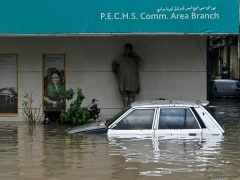Pakistan has been reeling from flooding triggered by torrential rains, with nearly 400 people killed since August 14.
On Wednesday, Karachi was inundated following a heavy downpour, paralysing the southern port city of 20 million people less than a week after deadly flash floods swept away villages in the northwestern province of Khyber Pakhtunkhwa.
More than 700 people have been killed in the flooding and landslides across the South Asian nation since June, with forecasters warning of further downpours until Saturday.
So why have floods in Pakistan been so intense, and what is the solution to the South Asian country’s flooding problem?
Where did it flood in Pakistan?
The Buner district in the Khyber Pakhtunkhwa province has been the worst hit, with more than 200 people killed and extensive damage to homes and public infrastructure across the northwestern mountainous province since August 14.
The Himalayan region of Gilgit-Baltistan, as well as Pakistan-administered Kashmir, was also affected.
Karachi, the capital of the southern Sindh province, was hit by floods after rainfall on Tuesday. Videos circulating on social media showed cars and motorbikes submerged in water.
How many people have died in the floods?
On Thursday, nine people died and 15 were injured across the country, according to the National Disaster Management Authority (NDMA). Seven of these deaths were in Khyber Pakhtunkhwa, while two were in Sindh.
On Wednesday, 41 people died and 11 people were injured across the country. At least 19 of these deaths were in Khyber Pakhtunkhwa, 11 deaths were in Sindh, and 11 deaths were reported in Gilgit-Baltistan.
Some 759 people have died, including 186 children, and 993 have been injured since the onset of the monsoon season in June. More than 4,000 houses have been damaged due to flooding in the same period.

What do rescue efforts look like?
The head of the NDMA, Lieutenant General Inam Haider Malik, said that more than 25,000 people had been rescued from flood-hit areas, Reuters reported on Wednesday.
The army and air force have also been pressed into action in rescue efforts.
On Wednesday, 2,300 people were treated in 14 active medical camps in Khyber Pakhtunkhwa, according to the NDMA. Relief items have also been distributed among those affected by the floods.
What is causing the floods in Pakistan?
While the exact cause of the floods is yet to be determined, several factors could have contributed to the deluge.
“While climate change plays a critical role in intensifying flooding events in Pakistan, other factors such as urbanisation, deforestation, inadequate infrastructure, and poor river management also contribute significantly,” Ayyoob Sharifi, a professor at Hiroshima University in Japan, told Al Jazeera.
Climate change
Sharifi told Al Jazeera that climate change is causing monsoon rainfall to intensify, resulting in more frequent extreme precipitation events.
A study co-authored by Sharifi and published in February this year, indicates that cities such as Lahore and Faisalabad could experience increased rainfall under certain scenarios, heightening the risk of urban flooding.
He added that rising temperatures allow the atmosphere to hold more moisture, leading to heavier downpours during storms. In northern Pakistan, these higher temperatures are also accelerating glacial melting, which increases the likelihood of glacial lake outburst floods (GLOFs). These are floods that occur when water is suddenly released from a glacial lake.
Earlier this month, a GLOF occurred in Pakistan’s northern region of Hunza, when the Shisper Glacier swelled the Hassanabad nullah, damaging infrastructure and destroying cultivable land, Dawn reported on August 8.
While Pakistan is responsible for less than 1 percent of global greenhouse gas emissions according to European Union data, the country bears the brunt of climate disaster, the country’s former Finance Minister Miftah Ismail told CNBC in 2022.
Heavy rain over a short period
Fahad Saeed, a climate scientist at the Berlin-based think tank, Climate Analytics, told Al Jazeera that the flooding was caused by higher-intensity rainfall. This means that there was a large amount of rain over a short period.
In Buner, more than 150mm (6 inches) of rain fell in just one hour on Friday morning.
In 2022, Pakistan endured its most severe monsoon season ever recorded, resulting in at least 1,700 deaths and causing an estimated $40bn in damage. Saeed said the 2022 floods were unexpected because of the areas they hit, ravaging arid or semiarid parts of northern Sindh that usually do not experience heavy rainfall.
However, rainfall this year has occurred within or around the region that normally experiences monsoon rain, he said. What is unusual this time is the sheer intensity of the rain.
Soil unable to absorb the rain in rural areas
Saeed explained that when there is rapid rainfall in a rural area over a short time, the soil does not get enough time to absorb the rainwater. “The rain doesn’t infiltrate into the soil, rather, it flows off the surface. It results in mudslides and soil erosion.”
This applies to rural areas in the northern parts of Khyber Pakhtunkhwa and parts of Gilgit-Baltistan.
“What happens is that normally, if you are living next to the rivers, your house is prone to get destroyed or inundated. But this time, what happened is that even if you are on the slopes of the mountain, the rainfall is so intense that because of the mudslide and the landslides, it destroyed the homes at the elevations,” Saeed explained.





